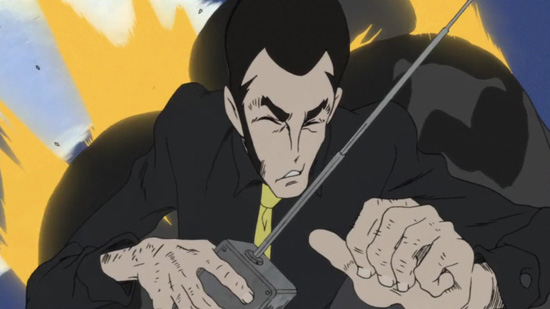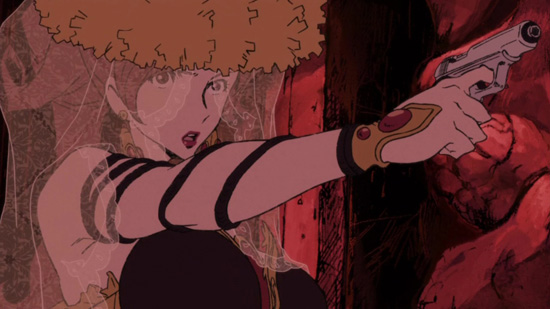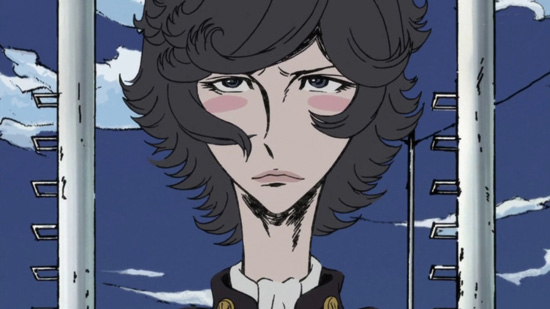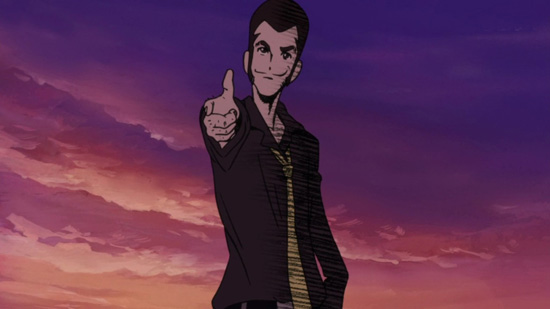The best scene by far in Lupin III: The Woman Named Fujiko Mine (hereafter Fujiko) is the opening sequence. In 90 seconds, Fujiko Mine (voiced by Miyuki Sawashiro) makes a bold, irrational spoken-word statement of intent over ominous strings and a series of surreal images of the nude Fujiko. It’s about her nihilism, her sense of mystery, the strange compulsions that drive her. The sequence leaves no doubt that this is definitely one of those artsy things.
So do the credits. Sayo Yamamoto (Michiko e Hatchin) directs, Takeshi Koike (Redline) does character design and animation direction, Dai Sato and Mari Okada are among the writers, and some of the industry’s finest animated it. (See Anipages for commentary and a thorough rundown of who does what where in a continuing series on Fujiko.) The art is decidedly in tribute to original creator Monkey Punch, and in contrast to most Lupin anime this is definitely an R-rated effort.
But is this the kind of artsy production that has a genuinely interesting angle on the least defined of a classic set of characters… or are the creators just pretentiously spinning their wheels? Unfortunately, it winds up decisively in the latter camp. The most potentially exciting anime TV series of a strong season manages to disappoint as much as it entertains, by copping out on its own mission statement.


Most of Fujiko proceeds like a typical Lupin III series, moving from one unrelated caper to the next. There is the hint of continuity, as it has the pleasure of doing an origin story for these classic characters — one take of many (don’t think about the canon!) on how Lupin, Jigen, Goemon, Fujiko and Inspector Zenigata became so inextricably intertwined in their business dealings. The episode that gives Jigen’s backstory as a mafia assassin is a highlight, nailing the gruff, soft-hearted gunman’s personality perfectly.
Zenigata is a notably different character here, a proud, cold-blooded, and quite competent cop rather than the bumbling old man you may be used to from other Lupin stories. Pops has also been given a partner, an androgynous embodiment of overwrought 70’s shoujo melodrama named Oscar (get it?), whose romantic obsession with Zenigata and jealousy of Fujiko has driven him to madness. The show is never able to shake off the feeling that this character has been beamed in from another anime.
Indeed, for a character given as much screen time as he is, I’m not really sure what was intended with Oscar. A foil for Fujiko, maybe, but he’s as impotent in that regard as the bumbling Zenigata seen in other Lupin series. We just get to watch him dress up convincingly like a woman and eventually go hootin’, hollerin’ Yosemite Sam crazy. At the end of the show he’s just left screaming “Bad girls should burn!!” while setting a castle on fire.
No, seriously, that’s Oscar’s final sign-off for this show. We don’t see him again.


Contrary to the treatment of the other characters, it often ironically feels that Fujiko isn’t getting a whole lot of attention in her own show. When her character comes upon the question “why?”, usually at the close of the early episodes, she answers “just because” and runs off nude (the nudity eventually starts to feel arbitrary, to the point where we feel like we’re meeting a per-episode nipple quota). She’s treated as a total enigma, with the occasional hint that we might eventually find out something about her. Unfortunately, and this is the show’s ultimate intention, we never do.
These episodes are hit and miss, with a few excellent stand-alone chapters and some duds. Likewise, the animation goes from caper action and spectacle reminiscent of Koike’s best in the first episode to the occasional episode where the animators take a break for a bit while the camera pans from left to right for 25 minutes. (This episode, which takes on the Cuban Missile Crisis, is actually one of the stronger ones.) The up-and-down animation quality of this show gives the impression that it was put together as fast as possible (for example, in the first episode neither the opening nor the ending animation was actually finished!), perhaps by the skin of the production staff’s teeth. Their talent nevertheless shows through: uneven as the animation is, Fujiko completely outshines its contemporaries.
As a mostly episodic series, the big problem with The Fujiko Show comes when it’s about to finish. Realizing there isn’t a lot of time left, the show shift gears abruptly and ties everything together with a single, unbelievably dumb story.
(The major spoilers start now.)


This series is sold as an origin story, and throughout it has been heavily implied through flashbacks that Fujiko Mine is the product of severe physical and sexual abuse throughout her formative years on the part of some incredibly powerful entity, a society of omniscient owl-headed monsters which also control her mind (as if the other abuse wasn’t enough!). As such, we spend the last four episodes of the show dealing with this directly.
If the rest of the show sometimes didn’t feel like Lupin, these episodes turn Fujiko into another show entirely: suddenly we’re in a weird sci-fi mystery unraveling a multitude of secret operations within a sinister, powerful pharmaceutical corporation. Hallucinations and explanations are the order of the day for this segment of the show, as Mari Okada loads every piece of this show’s real story into speeches delivered by unreliable narrators, while Lupin and friends contend with malevolent illusions. These episodes are definitely among the show’s most beautifully drawn, I’ll give them that… but unfortunately they don’t lead anywhere interesting.
You see, in the last ten minutes or so of the show, after episodes of unraveling this story, they tell you it was all bullshit. The whole business has absolutely nothing to do with Fujiko Mine; rather, it involves some villains who we unmask in the final moments and who promptly explain themselves ala Metal Gear Solid or Scooby-Doo. Fujiko was always the way she is, having only recently suffered from temporary memory replacement. Those childhood memories and fears were planted on her. Everything was because of acid and MKULTRA, the show says.
So the final stroke of the show is to cop out on Fujiko. Much of the time we’ve spent with the show, especially this final arc, suddenly feels like it was completely wasted. No amount of literary allusion and symbolism — and the show is awash in it — makes up for the fact that all this posturing winds up being completely empty.


What made Fujiko Mine? Well, what made Lupin III? What made Golgo 13? It doesn’t really matter, does it? These characters aren’t really about their pasts, they’re about the job they’re on right now. But if that’s truly the case, please don’t make an entire TV show that begs the question and then three months later tells you that it’s a stupid question to ask. If that was the point, we could have done it in an hour and the animators could have had an easier time of it.
There is a part of Fujiko‘s twist ending, something that Yamamoto and Okada might have been trying to say, that resonates with me and that I can appreciate.
At the end of the show, Fujiko tells the forces that dared try to shape her to go fuck themselves. That’s a universal feeling. It extends to our expectations of this show. Go fuck yourself, she says, for assuming that a woman who steals and screws and kills without remorse could only be produced by a lifetime of childhood abuse and brainwashing. Go fuck yourself for deciding that I’m damaged, says Fujiko, and fuck you for telling me who I am.
And implicitly, she’s kind of saying to us, “Fuck you for trying to figure me out.” But it doesn’t count as implicating the viewer when you directly say one thing and then say you were lying.
And then Fujiko makes sure her oppressor — who, by convoluted plot twists, was the true victim of all the shocking abuse we were shown onscreen — dies watching her frolic on the beach for no other reason than to make her suffer. That’s Fujiko Mine. She’s not a nice person, or even a good one: in fact, she’s the meanest person in this show. She is herself, without apology.


These rare notes are wonderful. Fujiko has a brilliant idea for a finale in it. There are some fantastic individual scenes… but none of it comes together. It’s not just Oscar’s arc that doesn’t feel like it was properly planned out… it’s everything. Maybe it’s the lack of focus on the stated protagonist. Maybe it’s the sudden change in tone two-thirds through. Maybe it’s the cop-out ending. It’s all this stuff working together that makes the show feel terribly unsatisfying when you’re done.
So should you spend your six hours with this show? Yes, actually. It’s uneven, it’s deeply flawed, it doesn’t deliver on what it promises, but you should definitely watch Fujiko. As far as what it was trying to do, it may well be a failure… but there are some really good episodes of Lupin the Third in there.











